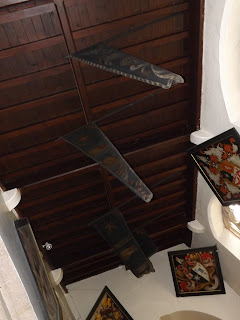The 88th Annual Conference for Rotary
International in Great Britain & Ireland was held at Harrogate. The first ever Conference of the then British
Association of Rotary Clubs choose Harrogate as its inaugural venue in 1920 and
the only other conference held there was in 1928 so it was a long overdue visit
to North Yorkshire.
I’d not been to a RIBI Conference before, but wanting to
make the most of the opportunities my presidential year has afforded me, I
booked. I also had happy memories of
previous conferences to Harrogate and this gave me an added incentive to go.
The one previous time I attended Harrogate International
Conference Centre was for a Salvation Army Congress weekend. That weekend was probably the last ‘religious’
high movement I experienced before I left the ministry and my faith took a big
knock.
As I entered the auditorium for the first session, I experienced
a flashback to the last time I was in that room. It had a special time, my personal journey
since then has been quite hard and emotional in places, and I did shed a tear
or two.
Outside of the Conference, I explored the local
vicinity. Harrogate itself is renowned as
a Spa Town with many fine examples of Georgian architecture.
I like to visit places ‘off of the beaten track’ to coin a
phrase and spent a couple of hours nearby in a village called Ripley. This caught my attention because not far from
Hucknall is a Derbyshire town bearing the same name. This Ripley is probably best known for the
manufacture of the ‘World-famous Ripley Ice Cream.’ Although it was cold for April I did see
people purchasing and eating some.
In the Churchyard was a Grade II listed monument called ‘The
Weeping Cross.’ Its origins is unknown but it is thought to have been used by
pilgrims and penitents and so has ‘kneeholes’ so that devotes could kneel in
prayer at the foot of a cross embedded in stone. There are no other crosses like it known in
England.
The church itself had some interesting features including
memorials for the Ingilby family. Sir Thomas
Ingilby was knighted by Edward III after saving the King’s life from a wild
boar. Wild boars are featured all over the village (
fortunately, there were none at the RIBI conference in Harrogate!). Sir William Ingilby entertained James I on
his journey to London to ascend to the English throne. During this period of history, the Ingliby
family were linked with the failed Gunpowder plot of Guy Fawkes. Sir William Ingilby’s funeral pennants still
hang in the church to this day. His
namesake, another Sir William Ingilby, had been a priest before he inherited
the castle and was opposed to alcohol consumption on the Sabbath. When, in 1919, he ordered that all 3 village
landlords close their hostelries on Sundays, they decided to move away as the Sabbath
was their most lucrative day. Ripley was
a ‘dry’ village until 1990 when the Ingilby family opened ‘The Boar’s Head
Hotel.’
At the centre of this village is Ripley Castle which has
been the home of the Ingilby family for 700 years. The church also bears several interesting
features. A nineteenth century Ingilby
tore down the old village, rebuilt it modelling if after an Alsatian village
with a hotel de ville style town
hall. The castle and the church were not affected by the reconstruction.
As you can tell, this village made quite an impression on
me.
I also visited Ripon the oldest city in England (and fourth smallest city). The huge cathedral dominates this market town. I was interested to learn of the tradition of the Wakeman which has carried on unbroken for 900 years until today. The Wakeman was the official keeper of law and order in Ripon. This tradition is celebration every night at 9 o’clock when the Wakeman sounds his horn to show that he is on duty and watching over the citizens of Ripon.






No comments:
Post a Comment